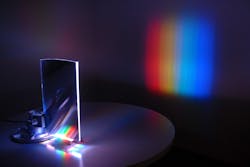OPTICS FOR DISPLAYS: Waveguide-based wedge creates collimated display backlight
Micro-optics and diffusion materials are often used to spread light from fluorescent tubes uniformly across a display for backlighting; however, these optical materials are typically filled with diffusive particles and cause reflections and refractions that limit light transmission. Light-emitting diodes (LEDs) are increasingly being used as backlights, but a large number of devices are needed to illuminate a large area, increasing backlighting costs. A promising new approach to display backlighting is to use a small number of LEDs directed into a clear waveguide-based wedge developed by researchers at Microsoft (Redmond, WA).1 The wedge has the further capability of potentially removing the need for color pixel filters and halving backlight power consumption.
Collimation without bulk
The wedge-shaped optic is unusual in that, as well as spreading the light out uniformly, the optic collimates it. Like a searchlight, there is a lamp and a curved mirror, but the space in between is a waveguide instead of free space. The end of the waveguide sees only a section of the curved mirror but forms multiple images of it like a kaleidoscope; that is, the reflected light is collimated as if it came from the focal point of a sphere. The direction of the collimated reflection can be steered by embossing the curved mirror with facets, like those of a Fresnel prism. The reflection is steered toward the critical angle and the waveguide is tapered so that by the time one reaches the thin end where the original source is, all the reflected light has emerged in parallel from the top or bottom surface of the wedge.
In one experiment, a 320-mm-long prototype wedge was fabricated from polymethylmethacrylate and tapered over that length from 6.2 mm (thin end) to 10.8 mm (thick end). The facets on the thick end of the wedge are prisms on a 1 mm pitch that are embossed and then metallized. Red, green, and blue LEDs placed at the thin end produced a collage of collimated color outputs simulating how the wedge optic could be applied in a backlighting application (see figure). While an off-center LED does produce a shadow in the final image, pairing two LEDs equidistant from the center of the thin end of the wedge eliminates this shadow and creates uniform illumination.
The researchers estimate that in single-user applications, the power consumption of a liquid-crystal-display (LCD) backlight can be decreased by a factor of at least three if the wedge-shaped backlight is substituted for an array of two-dimensional LEDs. Uniformity values of ±10% and light-guide efficiency values of 70% have been realized with prototype devices when using only one LED.
More than backlighting
Even when the image on the LCD must be made visible to many users, a red, green, and blue LED can be imaged through the wedge optic by a lenticular array onto the color cells within a liquid-crystal panel to halve power consumption. "This device shows how a smart backlight lets a liquid-crystal panel be more than a dumb display," says Adrian Travis, a researcher in Microsoft's Applied Sciences Group. "With collimated illumination, only the user gets to see the image, so the screen is both private and uses a small fraction of the light and power otherwise needed. Furthermore, there is the opportunity to make an alternating pair of images visible to slightly different directions, possibly enabling stereo imaging without spectacles."
REFERENCE
- A. Travis et al., Optics Express 17(22) p. 19714 (Oct. 26, 2009).

Gail Overton | Senior Editor (2004-2020)
Gail has more than 30 years of engineering, marketing, product management, and editorial experience in the photonics and optical communications industry. Before joining the staff at Laser Focus World in 2004, she held many product management and product marketing roles in the fiber-optics industry, most notably at Hughes (El Segundo, CA), GTE Labs (Waltham, MA), Corning (Corning, NY), Photon Kinetics (Beaverton, OR), and Newport Corporation (Irvine, CA). During her marketing career, Gail published articles in WDM Solutions and Sensors magazine and traveled internationally to conduct product and sales training. Gail received her BS degree in physics, with an emphasis in optics, from San Diego State University in San Diego, CA in May 1986.
